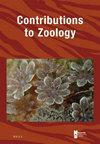盖形鲨Apristurus ampliceps的生物发光样鳞片(软骨鱼类:Elasmobranchii)
IF 2.2
2区 生物学
Q1 ZOOLOGY
引用次数: 13
摘要
Galeomorph鲨是现存塞拉奇亚目中分类学和生态多样性最强的超目。尽管包括几个典型的深水类群,但到目前为止,该类群中还没有生物发光物种的报道。有趣的是,近年来对鲨鱼鳞片的研究被证明是推断鲜为人知物种某些生态方面的一个很好的替代品。特别是,目前已知的所有生物发光鲨鱼的真皮小齿和鳞片模式的高度形态特异性可能构成预测化石和活体分类群生物发光的潜在工具。根据这一想法,我们通过对Apristurus ampliceps鳞片模式的定量研究,首次提供了支持方头鲨可能存在生物发光的证据。经典的形态计量分析和多变量统计程序使我们能够确定A.ampliceps鳞片主要由刚毛状的真皮小齿组成,与生物发光鲨鱼Etmopterus spinax的鳞片高度趋同。A.ampliceps是一种专门栖息在无光水域的物种,其生态学与这种形态功能解释一致,但必须找到光电泳来证实这一预测。本文章由计算机程序翻译,如有差异,请以英文原文为准。
Bioluminescent-like squamation in the galeomorph shark Apristurus ampliceps (Chondrichthyes: Elasmobranchii)
Galeomorph sharks constitute the most taxonomically and ecologically diverse superorder of living selachians. Despite comprising several typically deep-water taxa, no bioluminescent species have been reported in this group so far. Interestingly, the study of shark squamation has been revealed in recent years to be a good proxy for inferring some ecological aspects of poorly known species. In particular, the high morphological specificity of the dermal denticles and the squamation patterns of all currently-known bioluminescent sharks could constitute a potential tool for predicting bioluminescence in both fossil and living taxa. Following this idea, we provide the first evidence supporting the possible existence of bioluminescence among galeomorph sharks by means of the quantitative study of Apristurus ampliceps squamation pattern. Classical morphometric analysis and multivariate statistical procedures have allowed us to determine that A. ampliceps squamation, composed mainly of bristle-shaped dermal denticles, is highly convergent with that of the bioluminescent shark Etmopterus spinax. The ecology of A. ampliceps, being a species that exclusively inhabits aphotic waters, is in agreement with such a morphofunctional interpretation, but finding photophores is imperative to confirm this prediction.
求助全文
通过发布文献求助,成功后即可免费获取论文全文。
去求助
来源期刊

Contributions to Zoology
生物-动物学
CiteScore
4.00
自引率
4.50%
发文量
16
审稿时长
>12 weeks
期刊介绍:
Contributions to Zoology solicits high-quality papers in all systematics-related branches of comparative zoology (including paleozoology). Preference will be given to manuscripts dealing with conceptual issues and to integrative papers (e.g., ecology and biodiversity, morphology and phylogeny and character state evolution, phylogeny and historical biogeography, systematics and bioinformatics, bioinformatics and biodiversity, habitat disturbance and biogeography, etc.). Reviews and alpha-taxonomic contributions are considered for publication, but acceptance will depend on their high quality and exceptional nature.
 求助内容:
求助内容: 应助结果提醒方式:
应助结果提醒方式:


